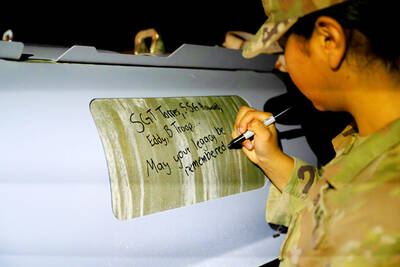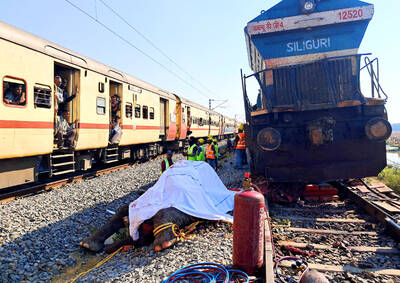The US Air Force announced on Wednesday that it will retire the most modern cruise missile in the US nuclear arsenal, a "stealth" weapon developed in the 1980s with the ability to evade detection by Soviet radars.
Known as the Advanced Cruise Missile, the weapon is carried by the B-52 bomber and was designed to attack heavily defended sites. It is the most capable among a variety of air-launched nuclear weapons built during the Cold War that remain in the US inventory even as the Pentagon is reducing its overall nuclear arms stockpile.
The Air Force had said as recently as February last year that it expected to keep the missile active until 2030.
If the retirement is carried out as planned, the Advanced Cruise Missile will be the first group of US nuclear weapons to be scrapped since the last of the Air Force's 50 MX Peacekeeper land-based missiles was retired in September 2005.
The decision to retire the fleet has not been announced. It was brought to light by Hans Kristensen, director of the nuclear information project at the Federation of American Scientists.
He noticed that money for the program was cut in the Air Force budget request for next year, and no money is budgeted for it beyond next year; when he inquired, the Air Force acknowledged the retirement decision.
An Air Force spokeswoman, Major Morshe Araujo, confirmed it on Wednesday. She and other Air Force public affairs officials were unable to provide additional details, including the rationale for the decision.
Araujo indicated that the retirement was part of a "balanced force reduction" being carried out to reduce the number of US strategic nuclear weapons to between 1,700 and 2,200 by Dec. 31, 2012, as required under a US-Russian arms reduction deal signed in Moscow in May 2002.
The treaty does not require that any specific group of nuclear weapons be retired, only that the total number in the US and Russian arsenals be cut to the prescribed range of 1,700-2,200. The Russians still have a nuclear-tipped cruise missile in active service, according to Robert Norris, an expert in American, Soviet and Chinese nuclear weapons.
The Defense Department does not confirm the location of nuclear weapons, but private nuclear experts said the fleet of more than 400 Advanced Cruise Missiles is at the nation's two B-52 bomber bases.

The Burmese junta has said that detained former leader Aung San Suu Kyi is “in good health,” a day after her son said he has received little information about the 80-year-old’s condition and fears she could die without him knowing. In an interview in Tokyo earlier this week, Kim Aris said he had not heard from his mother in years and believes she is being held incommunicado in the capital, Naypyidaw. Aung San Suu Kyi, a Nobel Peace Prize laureate, was detained after a 2021 military coup that ousted her elected civilian government and sparked a civil war. She is serving a

REVENGE: Trump said he had the support of the Syrian government for the strikes, which took place in response to an Islamic State attack on US soldiers last week The US launched large-scale airstrikes on more than 70 targets across Syria, the Pentagon said on Friday, fulfilling US President Donald Trump’s vow to strike back after the killing of two US soldiers. “This is not the beginning of a war — it is a declaration of vengeance,” US Secretary of Defense Pete Hegseth wrote on social media. “Today, we hunted and we killed our enemies. Lots of them. And we will continue.” The US Central Command said that fighter jets, attack helicopters and artillery targeted ISIS infrastructure and weapon sites. “All terrorists who are evil enough to attack Americans are hereby warned

Seven wild Asiatic elephants were killed and a calf was injured when a high-speed passenger train collided with a herd crossing the tracks in India’s northeastern state of Assam early yesterday, local authorities said. The train driver spotted the herd of about 100 elephants and used the emergency brakes, but the train still hit some of the animals, Indian Railways spokesman Kapinjal Kishore Sharma told reporters. Five train coaches and the engine derailed following the impact, but there were no human casualties, Sharma said. Veterinarians carried out autopsies on the dead elephants, which were to be buried later in the day. The accident site

‘NO AMNESTY’: Tens of thousands of people joined the rally against a bill that would slash the former president’s prison term; President Lula has said he would veto the bill Tens of thousands of Brazilians on Sunday demonstrated against a bill that advanced in Congress this week that would reduce the time former president Jair Bolsonaro spends behind bars following his sentence of more than 27 years for attempting a coup. Protests took place in the capital, Brasilia, and in other major cities across the nation, including Sao Paulo, Florianopolis, Salvador and Recife. On Copacabana’s boardwalk in Rio de Janeiro, crowds composed of left-wing voters chanted “No amnesty” and “Out with Hugo Motta,” a reference to the speaker of the lower house, which approved the bill on Wednesday last week. It is